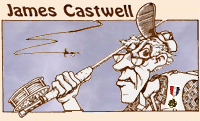|
In most of my fly casting sessions I use the
example of Mike Tyson. No, nothing to do with
ear-biting; fly-casting. Now, I have no idea
whether he fly-casts or not, but I will say this.
I think, if he wanted to, he would be a very, very
good caster. I would welcome the opportunity to
teach him in fact.
Most of you have an image of him in a fight; he comes
in low, no long punches, elbows bent, tight, short,
from the shoulder, power developed with his biceps.
What you will not see him doing is hitting with his
arm extended. Why not? No power that way. Forgive me,
but I have seen some guys casting who looked a lot
like some old lady smacking a guy over the head with
an umbrella; same exact motion, really.
I am going to assume by now you know something about
casting. This you can do right now. At your computer.
I dare you to try it. (Make sure no one can see you
though, looks silly) Put your left hand on your right
bicep. (The big muscle between your elbow and shoulder)
Ok, now while holding the left hand there, make some
pretend casting strokes with your right arm.
You already know you need to stop the rod to form
line-loops, so make sure you come to a nice hard stop
in both directions. Notice how the bicep muscle is
involved. You can feel it with your left hand; that
is if you have not raised your right arm! Keep the arm
down and the bicep works. It stops the rod.
Now try this. Raise your right arm way up. Almost
straight up like you have seen some guys try to cast.
Repeat the casting strokes with it up like that. Notice
how the bicep no longer even moves? Try stopping the
rod with your arm up like that. Doesn't work, does it?
The point here is this. If you need to stop the rod
to form nice tight loops, use the best muscle for the
job. If you raise your arm, all you have to use is your
wrist. Lower it and you have the power of your bicep
to do the job right. This is the main point the first
FFF 'Master' Certified Casting Instructor, Rich Ward,
drills into every student.
Of course this is much more important when casting a
longer fly line. For short stuff you can stop the rod
with your wrist or forearm. Some casts require hardly
any stop at all.
As a fly-caster moves up from the four or five weight
rods to the eights, he needs to learn how to stop the
rod better. With rods this size he is required to cast
longer distances. At the same time he is using a rod,
heavier, which is harder to stop than the light ones.
This sometimes retards the development of learning the
hard stop. The caster often tries to cast them the same
way he did the light ones, big gentle loops. When that
does not work, he swings them harder. That of course,
does not work at all. He has to learn the stop. ~ JC
|





